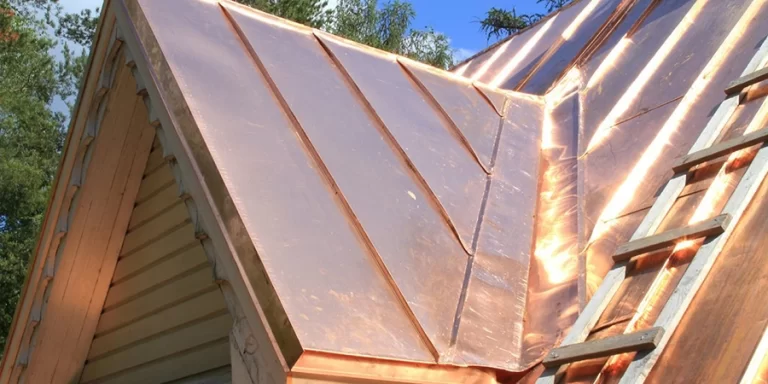Comparative Analysis of Slate Roof and a Metal Roof
The choice of roofing material is an important decision that greatly affects the aesthetics, durability and functionality of a building. Among the many options available, slate and metal stand out as two popular choices, each with a unique set of features. In this comprehensive article, we look at the nuances of slate roofs and metal roofs, comparing their features, pros, cons, and environmental impact.
Slate Roofs:

Origins and Characteristics:
Slate, a metamorphic rock derived from shale or clay, has been used as a roofing material for centuries. Its natural composition gives it a distinct charm, as each slate has a unique color and texture. Available in a range of earth tones such as grey, green, purple and black, slate roofing exudes an elegant and timeless beauty.
Durability and Longevity:
Slate roofs are renowned for their exceptional longevity, often exceeding a century if properly maintained. The natural density of slate makes it resistant to fire, extreme temperatures and high weather. Additionally, slate is free from rotting, pests, and fungi, making it an ideal choice for areas prone to moisture.
Aesthetics and Architectural Significance:
Slate roofs have the innate ability to enhance the architectural character of a building. They perfectly complement historical and traditional structures, adding realism and grandeur. The different sizes and shapes of slate tiles allow the creation of intricate patterns and designs that contribute to the aesthetic beauty of the roof.
Maintenance and Cost:
While slate roofs are undeniably durable, they require specialized installation by trained professionals due to their weight and fragility. Routine maintenance, such as replacing damaged tiles and cleaning gutters, is essential to ensure their longevity. However, initial installation costs are significantly higher than with other roofing materials, partly due to the labor-intensive process.
Environmental Impact:
Slate roofing has the advantage of environmental impact due to its natural origin and long life. They are non-toxic, recyclable and produce minimal waste in landfills. Energy consumption in production and transportation is relatively low compared to composite roofing materials.
Metal Roofs:

Variety and Adaptability:
Metal roofing covers a wide variety of materials including steel, aluminum, zinc, and copper. Each material has unique characteristics, such as the strength of steel, the lightness of aluminum, the corrosion resistance of zinc and the unique aging process of copper. This versatility allows homeowners to choose the metal that best suits their preferences and climatic conditions.
Durability and Longevity:
Metal roofs are known for their outstanding durability. They are highly resistant to fire, wind, hail and UV rays. With the right coatings and finishes, metal roofs can maintain their look and function for decades. However, the life span of metal roofs can vary depending on the selected material, coating and local environmental factors.
Energy Efficiency:
One of the notable advantages of metal roofing is its energy efficiency. Reflective coatings and insulation systems can significantly reduce heat absorption, reducing cooling costs in warmer climates. In addition, the recyclability of metal roofing materials contributes to sustainability.
Installation and Maintenance:
Metal roofs are relatively light compared to slate so installation is less labor intensive. Interlocking panels or shingles simplify the installation process and the dowels are concealed, improving the roof’s aesthetic. Regular maintenance includes checking for loose fasteners, damaged coating or corroded areas.
Modern Aesthetics and Appeal:
Metal roofs have evolved from their utilitarian image to become an icon of modern architecture. The clean lines and sleek look of metal roofing make it a popular choice for modern homes and commercial buildings. The availability of different colors and configurations enhances their aesthetic versatility.
Environmental Impact:
The environmental impact of metal roofing materials varies depending on the metal used and the manufacturing process involved. Some metals, such as copper and zinc, require a lot of energy to extract and refine. However, the longevity and recyclability of metal roofing offsets these effects to some extent.

The choice between a slate roof and a metal roof ultimately depends on many factors, including architectural style, budget, climate, and personal preference. Slate roofs offer timeless elegance, unmatched longevity and a durable configuration, but come with a higher upfront cost and complexity of installation. Metal roofs, on the other hand, offer versatility, modern aesthetics and energy efficiency, with a wide range of materials and finishes to choose from.
As the construction industry continues to evolve, metal and slate roofing options will adapt to meet demands for aesthetics, performance and durability. Whichever option the owner or architect chooses, it is important to consider the long-term effects of the choice on the function, appearance, and environmental impact of the building.






























